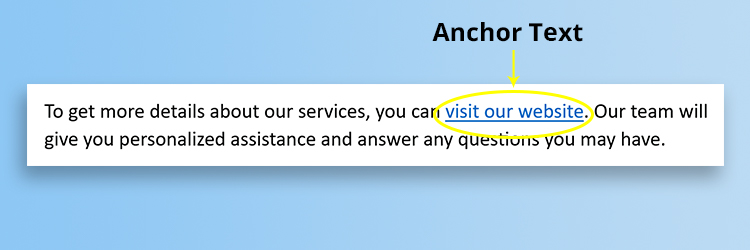Anchor text serves as a bridge between content and linked pages, aiding search engines in understanding page context and improving user experience. This article delves into the aspects of anchor text, exploring its types, purpose, and best practices for optimization.
List of Contents
- What Is Anchor Text in SEO?
- Types of Anchor Text in SEO
- Anchor Text Examples
- Importance of Anchor Text
- Best Practices for Anchor Text Optimization
What Is Anchor Text in SEO?
Anchor text in SEO refers to the clickable text in a hyperlink, typically underlined and in a different color, serving as a signal to both search engines and users about the linked content’s topic or destination.
Optimizing anchor text involves strategically selecting and utilizing relevant keywords to enhance a webpage’s visibility and ranking.
SEO companies often utilize anchor texts to improve their clients’ website rankings and visibility.
Types of Anchor Text in SEO
1. Exact Match
Anchor text precisely matches the targeted keyword of the linked page, aiding in direct relevance. For instance, linking “delicious chocolate cake recipe” to a webpage specifically offering a recipe for chocolate cake.
2. Partial Match
The anchor text contains a variation of the keyword, maintaining relevance without exact duplication. For example, linking “best chocolate cake recipe” to a webpage focused on various chocolate cake recipes.
3. Branded
Employing the company name as anchor text, guiding users directly to the company’s website. For instance, linking “XYZ Corporation” to the official website when discussing their products and services.
4. Naked Link
Integrating the website URL directly into the text as anchor text. For example, including “www.example.com” within a sentence about accessing the company’s online resources.
5. Site Name
Referring to the website’s name without the full URL, offering a straightforward link. For example, using “Example.com” as anchor text when mentioning the company’s website.
6. Generic
Non-specific anchor text lacking descriptive information, such as “click here” or “learn more.” It fails to provide context about the linked content, requiring additional context within the surrounding text.
7. Images
When linking through an image, the alt attribute serves as the anchor text, offering contextual information for search engines. For example, using the alt text “chocolate cake recipe” to link to a webpage featuring such content.
Anchor Text Examples
The example of an anchor text is highlighted in the image given below.

Importance of Anchor Text
Relevant and descriptive anchor text not only enhances website rankings on search engines but also improves user experience. It provides vital context to both search algorithms and readers, aiding in understanding site structure and content relevance.
Best Practices for Anchor Text Optimization
1. Consistent Anchor Text and Links
Ensure uniformity in your anchor text and linking approach across your webpage. Consistency enhances user experience and maintains the overall aesthetics of your site.
Keep anchor text concise and uniform in length to foster a cohesive appearance and navigation.
2. Relevance is Key
Link only to pages that are directly relevant to the anchor text and the overall theme of your content.
Aligning anchor text with relevant content enhances user engagement, boosts page rankings, and reinforces the credibility of your website in the eyes of search engines.
3. Variety in Anchor Text Phrases
Integrate a diverse range of anchor text phrases to avoid over-optimization and maintain a natural flow of content.
Rather than excessively linking identical phrases, prioritize linking related content only when it adds significant value to the reader’s understanding.
4. Natural Link Integration
Incorporate anchor text seamlessly within your content, ensuring it blends naturally without disrupting the reader’s experience.
By linking to relevant internal pages in a non-intrusive manner, you facilitate user navigation and encourage longer site engagement.
5. Avoid Generic Anchor Text
Steer clear of generic phrases like “click here” that offer little context about the linked content.
Instead, opt for descriptive anchor text that succinctly communicates the destination or purpose of the link, enhancing user comprehension and search engine visibility.
6. Differentiate Anchor Text from Keywords
Resist the temptation to use target keywords exactly as anchor text, as this can create confusion and dilute the effectiveness of your SEO efforts.
By diversifying anchor text and avoiding keyword repetition, you maintain page uniqueness and maximize ranking potential.
Wrapping Up: Anchor Text in SEO
Anchor text optimization is the foundation of an effective SEO strategy. By knowing about anchor text, and implementing best practices, websites can enhance their visibility, improve user experience, and ultimately achieve higher rankings on search engine results pages.


